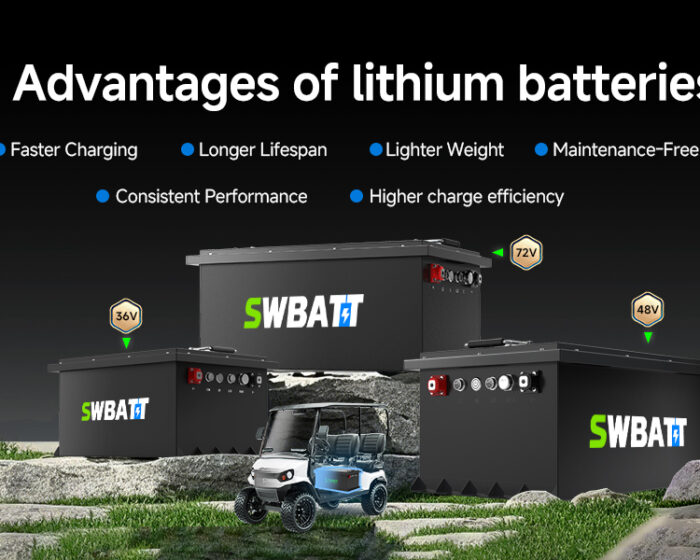As a lithium battery manufacturer specializing in power solutions for electric vehicles, we understand the critical role that charging plays in the overall performance and longevity of your Club Car fleet. Choosing the right Club Car charger isn’t just about plugging in; it’s about optimizing battery health, ensuring operational efficiency, and ultimately, maximizing your return on investment. This guide is designed specifically for B2B clients – dealerships, golf course operators, and fleet managers – who rely on Club Car vehicles and want to make informed decisions about their charging infrastructure. We’ll cover compatibility, charging best practices, and the significant advantages of transitioning to lithium battery systems and their associated chargers.
Understanding Club Car Charger Compatibility: Voltage, Amperage, and Connectors
Table of Contents
ToggleThe most fundamental aspect of selecting a Club Car golf cart battery charger is ensuring compatibility. Using the wrong charger can damage batteries, void warranties, and even create safety hazards. Here’s what you need to know:
- Voltage: Club Car primarily uses 48V systems, although older models may use 36V. Matching the charger’s voltage to the battery pack’s voltage is crucial. A 48-volt battery charger club car is explicitly designed for 48V systems. Never use a 36V charger on a 48V cart, or vice-versa.
- Amperage: The charging speed is determined by the amperage (amps). Higher amperage chargers charge batteries faster, but it is essential to choose a charger appropriate for your battery type and capacity.
- Lead-Acid: A charger with an output of 15-20 amps is typical for traditional lead-acid batteries.
- Lithium: Lithium batteries often handle higher amperage charging, allowing for significantly faster charge times. Chargers designed explicitly for lithium batteries may have 30 amps, 50 amps, or even higher outputs, depending on the battery’s specifications. Always consult the battery manufacturer’s recommendations.
- Connectors: Club Car has used several different connector types over the years. The most common are:
- Round 3-Pin (Crowfoot): This is a standard connector on older Club Car models.
- SB50 (Anderson SB50): A more robust connector, often found on newer models and frequently used with lithium battery systems.
- E.R.I.C: Introduced in 2014.
- Molded 3 Pin: Club Car’s Newest connector.
Key Point: Always double-check the voltage, amperage, and connector type before connecting a charger to your Club Car. Refer to your cart’s owner’s manual and the battery manufacturer’s specifications. Using the incorrect golf cart charger club car can lead to irreversible damage.
Types of Club Car Chargers: OEM vs. Aftermarket, Lead-Acid vs. Lithium
You’ll encounter several types of chargers in the market:
- OEM (Original Equipment Manufacturer) Chargers: These are chargers produced by Club Car or by a manufacturer authorized explicitly by Club Car. They are designed to meet the exact specifications of Club Car vehicles and batteries.
- Aftermarket Chargers: These are chargers produced by third-party manufacturers. Quality can vary significantly. While some aftermarket chargers are excellent, others may be poorly built or lack the necessary safety features. It’s crucial to choose reputable brands when considering aftermarket options.
- Lead-Acid Chargers: These chargers are designed specifically for traditional lead-acid batteries. They typically use algorithms optimized for the charging characteristics of lead-acid chemistry (bulk, absorption, float stages).
- Lithium Chargers: These chargers are designed specifically for lithium batteries (typically LiFePO4 in golf cart applications). They have a Battery Management System (BMS) that communicates with the battery to ensure safe and efficient charging. Never use a lead-acid charger on a lithium battery.
Table 1: Charger Type Comparison
| Feature | OEM Lead-Acid Charger | Aftermarket Lead-Acid Charger | OEM Lithium Charger | Aftermarket Lithium Charger |
| Compatibility | Guaranteed for Club Car | Varies; check carefully | Guaranteed for Club Car (with lithium) | Varies; check very carefully |
| Quality | High | Variable (low to high) | High | Variable (low to high) |
| Safety Features | Comprehensive | May be limited | Comprehensive | May be limited |
| Warranty | Typically good | Variable (often shorter) | Typically good | Variable (often shorter) |
| Price | Higher | Lower | Higher | Lower to Moderate |
| Charging Algorithm | Optimized for lead-acid | May not be fully optimized | Optimized for LiFePO4 | May not be fully optimized |
| BMS | No | No | Yes | Some have |
Why Lithium Chargers are Different (and Crucial):
Lithium batteries have very different charging requirements than lead-acid batteries. A Club Car 48v charger designed for lead-acid will not properly charge a lithium battery and can cause severe damage. Lithium chargers use a specific charging profile (often constant current/constant voltage) and communicate with the battery’s BMS to:
- Prevent overcharging
- Prevent over-discharging
- Balance the cells within the battery pack
- Monitor temperature and other safety parameters.
Discover Advanced Lithium Battery Solutions
Explore SWBATT‘s innovative LifePO4 batteries for electric vehicles, energy storage, and more. Tailored solutions to meet your energy needs with efficiency and sustainability.

The Lithium Advantage: Upgrading Your Club Car Charging System
While traditional lead-acid batteries and their associated chargers have been the standard for years, lithium battery technology offers significant advantages for Club Car fleets:
- Faster Charging: Lithium batteries can accept a much higher charge current, resulting in significantly faster charging times. This means less downtime and increased cart availability.
- Longer Lifespan: Lithium batteries typically last 4-6 times longer than lead-acid batteries, reducing the frequency of replacements and lowering the total cost of ownership.
- Lighter Weight: Lithium batteries are significantly lighter than lead-acid batteries, improving cart performance, handling, and range.
- Maintenance-Free: Lithium batteries require no watering, equalization, or terminal cleaning, saving significant labor costs.
- Consistent Performance: Lithium batteries maintain a consistent voltage output throughout the discharge cycle, providing a more robust and responsive driving experience.
- Higher charge efficiency: Lithium battery is much more efficient than lead-acid.
In case you want to learn how to install a lithium golf cart battery, please refer to this article:how-to-install-lithium-battery-in-golf-cart?
Table 2: Lead-Acid vs. Lithium Charging Characteristics
| Feature | Lead-Acid Charging | Lithium (LiFePO4) Charging |
| Charging Stages | Bulk, Absorption, Float | Constant Current (CC), Constant Voltage (CV) |
| Voltage Sensitivity | Sensitive to over-voltage and under-voltage | More tolerant, but BMS provides crucial protection |
| Temperature Sensitivity | Highly sensitive to temperature extremes | Less sensitive, but BMS monitors temperature |
| Charging Efficiency | 70-80% | 90-95% |
| Self-Discharge Rate | Relatively high (5-10% per month) | Very low (1-2% per month) |
| Memory Effect | Yes (partial charging can reduce capacity) | No |
Real-World Example:
“Coastal Carts,” a golf cart dealership, switched its rental fleet of 50 Club Car Precedent i2 carts to lithium batteries and compatible lithium chargers. They experienced the following benefits:
- Reduced Charging Time: Charging time decreased from 8 to approximately 3 hours.
- Increased Revenue: Carts were available for more daily rentals due to faster turnaround.
- Lower Labor Costs: Eliminated the need for battery watering and maintenance.
- Longer Battery Life: Projected battery lifespan increased from 3 years to 8+ years.
- Improved Customer Satisfaction: Renters appreciated the more powerful and consistent performance of the lithium-powered carts.
- Although the initial investment in lithium batteries and chargers was higher, the long-term cost savings and increased revenue quickly offset the difference.
Troubleshooting Common Club Car Charger Issues
Even with the best equipment, occasional charging problems can arise. Here are some common issues and troubleshooting steps:
Charger Doesn’t Turn On: Check the AC power outlet.
- Inspect the charger’s power cord for damage.
- Check the charger’s fuse (if applicable).
- Ensure the charger’s connector is correctly seated in the cart’s receptacle.
- Charger Turns On But Doesn’t Charge: Verify the charger’s voltage and amperage are correct for the battery pack.
- Inspect the battery connections for corrosion or looseness.
- Check the battery pack’s voltage with a multimeter. If the voltage is extremely low, the battery may be deeply discharged or damaged.
- If using a lithium battery, check the BMS for any error codes.
- Charger Charges Slowly: This is normal for lead-acid batteries nearing the end of their life.
- If using a lithium battery, check the charger’s output amperage. It may be lower than the battery’s maximum charge rate.
- High ambient temperatures can also slow down charging.
- Charger Makes Unusual Noises: Some humming or buzzing is normal, especially with older transformer-based chargers.
- Loud clicking, popping, or sparking is abnormal and indicates a problem. Disconnect the charger immediately.
Important Note: If you are unsure about any troubleshooting steps, consult a qualified technician. Working with high-voltage electrical systems can be dangerous.
Frequently Asked Questions (FAQs)
Q1: Can I use a 48 volt battery charger club car on a 36V cart?
A: No, absolutely not. This will severely damage the 36V battery pack and could create a fire hazard. Always match the charger voltage to the battery voltage.
Q2: How long does it take to charge a Club Car golf cart?
A: With lead-acid batteries, a full charge typically takes 8-10 hours. With lithium batteries and a compatible charger, a full charge can take as little as 2-5 hours, or even faster with high-amperage chargers.
Q3: Can I leave my Club Car charger plugged in all the time?
A: For lead-acid batteries, it’s generally not recommended to leave the charger plugged in continuously after the battery is fully charged, unless it’s a “smart” charger with a true float mode that maintains the battery without overcharging. For lithium batteries, it’s generally safe to leave the charger plugged in, as the BMS will prevent overcharging. However, it’s always best to consult the battery manufacturer’s recommendations.
Ready to upgrade your Club Car fleet to lithium power and experience the benefits of faster charging, longer battery life, and reduced maintenance? Contact our team of battery experts today for a personalized consultation and a custom quote. We’ll help you select the perfect lithium battery and charger system.




